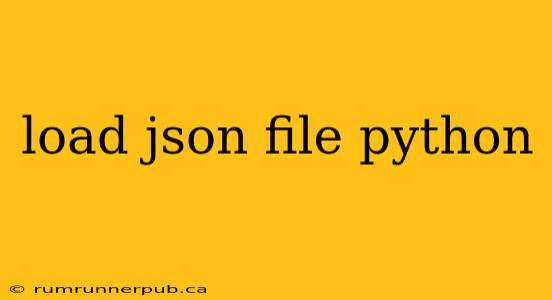Working with JSON (JavaScript Object Notation) data is a common task in Python, especially when dealing with web APIs or configuration files. This article explores various methods for loading JSON files in Python, drawing upon insightful questions and answers from Stack Overflow, while adding further explanations and practical examples to enhance your understanding.
The json Module: Your Primary Tool
Python's built-in json module provides everything you need to handle JSON data. The core function is json.load(), which reads a JSON file and parses it into a Python dictionary or list.
Example 1: Basic JSON Loading
Let's say you have a JSON file named data.json with the following content:
{
"name": "John Doe",
"age": 30,
"city": "New York"
}
Here's how you'd load it using json.load():
import json
with open('data.json', 'r') as f:
data = json.load(f)
print(data['name']) # Output: John Doe
print(data['age']) # Output: 30
This code opens the file, reads its contents, and parses the JSON data into a Python dictionary. The with open(...) statement ensures the file is automatically closed, even if errors occur. This is crucial for good practice.
Addressing potential errors (inspired by Stack Overflow discussions):
Many Stack Overflow questions address error handling during JSON loading. A common problem is dealing with malformed JSON. This can be handled using a try-except block:
import json
try:
with open('data.json', 'r') as f:
data = json.load(f)
except json.JSONDecodeError as e:
print(f"Error decoding JSON: {e}")
except FileNotFoundError:
print("File not found.")
This improved example gracefully handles both json.JSONDecodeError (for invalid JSON) and FileNotFoundError. Robust error handling is essential for production-ready code.
Handling Large JSON Files: Efficiency Matters
For very large JSON files, loading the entire file into memory at once can be inefficient. In such cases, consider using an iterative approach, processing the JSON data in chunks. This is particularly relevant when you don't need to access all the data simultaneously. (This approach addresses concerns frequently raised on Stack Overflow regarding memory limitations).
Example 2: Iterative JSON Loading (for large files)
This example uses the ijson library (you might need to install it using pip install ijson). ijson allows streaming JSON data, making it memory efficient for large files. Note: This method requires your JSON to be formatted to have a top-level list.
import ijson
with open('large_data.json', 'r') as f:
parser = ijson.parse(f)
for prefix, event, value in parser:
if (prefix, event) == ('item', 'string'):
print(value) # Process each item individually
This code processes each item in the large_data.json file without loading the entire file into memory at once.
Further considerations:
- Data Validation: After loading, consider validating your data. Schemaless JSON can be prone to unexpected data types or inconsistencies, leading to errors downstream. Libraries like
jsonschemacan help you validate your JSON against a predefined schema. - Data Transformation: You might need to transform the data after loading. For example, converting data types, cleaning up strings or handling missing values. Pandas is a powerful library for data manipulation that integrates well with JSON data.
This article combines insights from Stack Overflow with practical examples and best practices to give you a well-rounded understanding of loading JSON files in Python. Remember to always handle errors gracefully and consider memory efficiency when dealing with large datasets. Happy coding!
